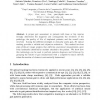Free Online Productivity Tools
i2Speak
i2Symbol
i2OCR
iTex2Img
iWeb2Print
iWeb2Shot
i2Type
iPdf2Split
iPdf2Merge
i2Bopomofo
i2Arabic
i2Style
i2Image
i2PDF
iLatex2Rtf
Sci2ools
IWANN
2005
Springer
2005
Springer
A Competitive-Based Method for Determining the Number of Groups: A Clinical Application
A proper gait assessment in patients with knee or hip injuries strongly determines the diagnosis and consequently the evolution of the pathology, the quality of life of implanted patients, and the overall costs involved. Among the different strategies to clinically assess gait, 3D optical tracking provides a reliable and objective evaluation. This method involves state-of-the-art image analysis that performs anatomical measurements upon bony landmarks identified by markers attached to the patient. We show how this technology can be used to perform patients diagnosis and follow-up by grouping the results of gait measurement with a competitive neural network where the number of clusters is automatically determined.
Related Content
| Added | 28 Jun 2010 |
| Updated | 28 Jun 2010 |
| Type | Conference |
| Year | 2005 |
| Where | IWANN |
| Authors | Antonio Sánchez, Francisco J. Vico, Santiago Cabello, Francisco J. Veredas, Yamina Seamari, Isaac López, Javier Farfán, Guillermo García-Herrera |
Comments (0)

